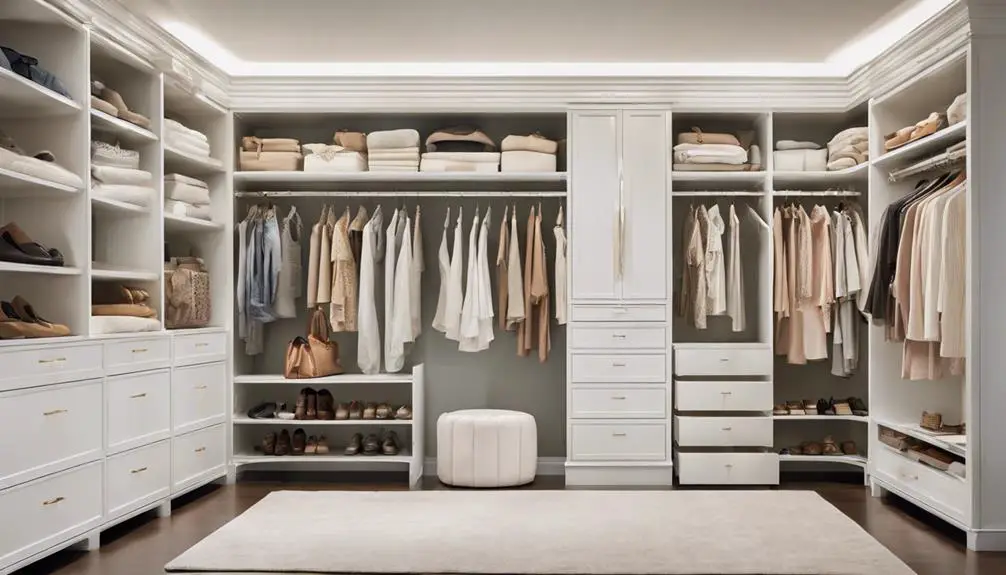As you stand in front of your closet, you can't help but feel overwhelmed by the clutter and disorganization. You know it's time for a change, but where do you start? Begin by taking stock of your closet's dimensions and identifying the areas that need the most attention. What are the must-haves, and what can you live without? By tackling these questions, you'll be one step closer to creating a peaceful and functional space that makes your daily routine a breeze. But that's just the beginning – and there's so much more to explore.
Assessing Your Closet Space
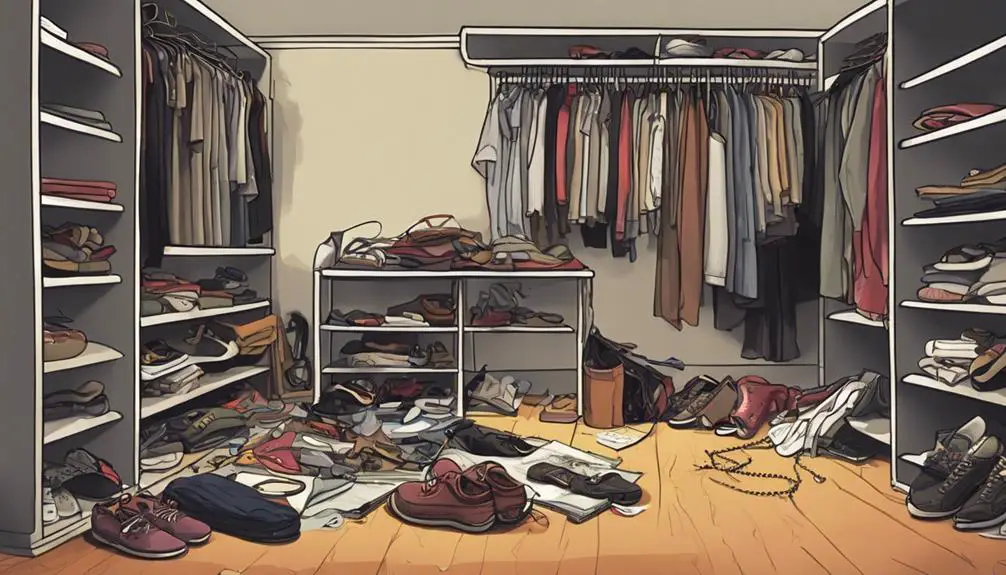
Evaluating Your Closet Space
Before you plunge into organizing your closet, take a step back and evaluate the space you're working with.
Measure the length, width, and height of your closet to determine its overall dimensions. Consider the location of any windows, doors, or obstacles that may impact your design. Identifying these space constraints will help you plan your layout and maximize your closet's potential.
Take note of the type of closet you have, whether it's a walk-in, reach-in, or wardrobe closet.
This will influence the type of storage solutions you can implement. Consider the position of the closet rod and shelves, and think about how you can optimize their use. Are there any areas that are difficult to access or seem wasted? Make a mental (or literal) note of these areas, as you'll want to address them in your organization plan.
Purge and Declutter Closet Items
You'll be surprised at how much clutter you've accumulated in your closet, and it's time to get rid of items that no longer serve a purpose.
Start by sorting items by type, such as tops, bottoms, dresses, and outerwear, to see what you have and what you can discard.
Get Rid of Clutter
Getting rid of clutter is the crucial first step in organizing your closet.
This is paramount to shift your clutter mindset and recognize that holding onto items "just in case" or because of sentimental value isn't worth the chaos it creates.
By letting go of clutter, you'll experience significant benefits, such as reduced stress, increased productivity, and a sense of control over your space.
Start by taking everything out of your closet and sorting items into three piles: keep, donate/sell, and discard.
Be honest with yourself about each item – when was the last time you wore it, and does it make you feel confident and happy?
If the answer is no, consider letting it go.
Consider the 80/20 rule, which suggests that 80% of the time, you likely wear 20% of your clothes.
This can help you prioritize what's truly necessary in your closet.
Sort Items by Type
With your closet contents sorted into three piles, it's time to take a closer look at the "keep" pile and categorize items by type.
This step is vital in creating a functional and organized closet space. Start by grouping similar items together, such as tops, bottoms, dresses, outerwear, and accessories.
Within these type categories, create item subsets like long-sleeve shirts, tank tops, and sweaters. This will help you visualize your wardrobe and identify patterns, making it easier to decide what to wear.
Consider categorizing items within each subset by color, season, or occasion. For instance, you can group summer dresses together and separate them from winter coats.
This level of detail will allow you to see what you have, what you need, and what you can donate or discard. By sorting items by type, you'll be able to create a logical and accessible closet system that saves you time and reduces stress.
Categorize and Group Similar Items
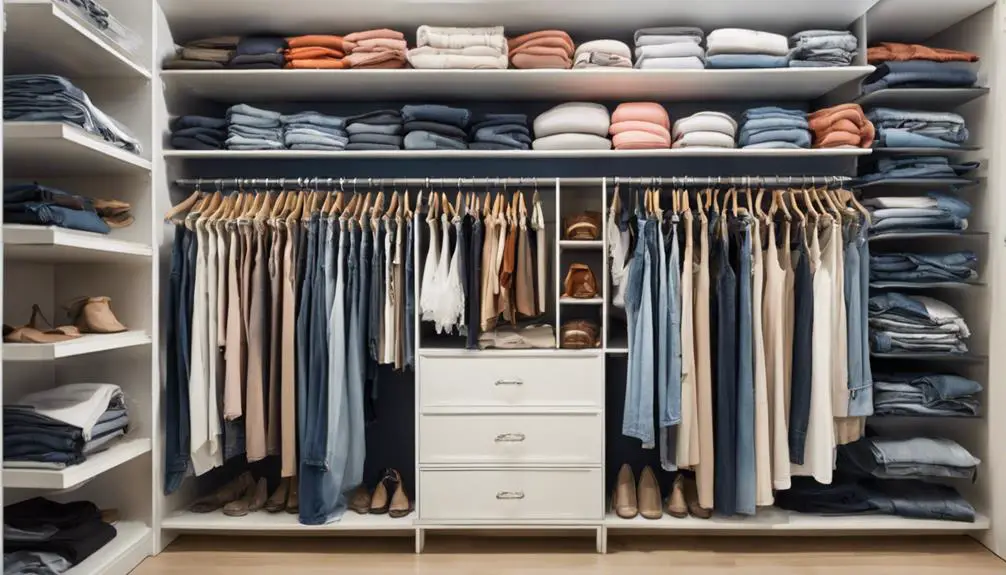
You'll want to sort your remaining items by type, such as tops, bottoms, dresses, and outerwear, to create a sense of order in your closet.
Next, group similar colors together within each category to create a visually pleasing and easy-to-navigate space.
Sort by Item Type
Your closet's chaotic landscape of clothes, shoes, and accessories begins to take shape when you sort by item type, categorizing and grouping similar items together.
This personalized sorting approach helps you create a customized categorization system that makes sense to you. Start by separating clothes into tops, bottoms, dresses, outerwear, and accessories.
Within each category, further divide items into subgroups, such as short-sleeve shirts, long-sleeve shirts, and tank tops. This level of detail guarantees that you can easily find what you need when you need it.
Next, apply the same principle to your shoes, grouping heels, flats, boots, and sandals together.
Accessories like hats, scarves, and belts can be categorized by type or occasion. By sorting by item type, you'll be able to see what you have, identify gaps in your wardrobe, and make intentional purchasing decisions.
This system also helps you maintain your closet's organization over time, as new items can be easily integrated into their designated categories.
Group Similar Colors
Sortation by item type sets the stage for a more nuanced approach: grouping similar colors.
This technique takes your closet organization to the next level by creating a visually pleasing and easy-to-navigate space.
You'll be applying the principles of color blocking and monochromatic style to create a harmonious palette.
Start by gathering items of the same color family, such as blues, greens, or neutrals.
Within each group, arrange items from lightest to darkest to create a seamless gradient effect.
This strategy helps you locate specific pieces quickly and makes mixing and matching outfits a breeze.
For instance, you can see all your blue tops together, making it easy to pair them with the perfect bottoms.
To take it a step further, consider grouping similar shades of the same color, like different hues of blue, from sky blue to navy.
This monochromatic approach creates a sense of cohesion and makes your closet feel more luxurious.
Store by Frequency
A well-organized closet is like a treasure trove, where every item is a precious gem waiting to be discovered.
To maximize your closet's potential, making it a priority to store items based on their frequency of use.
This approach guarantees that your most-worn pieces are easily accessible, while infrequent items are tucked away to avoid clutter.
Start by categorizing your belongings into three groups: daily, weekly, and occasional use.
Hang your daily wearables, like work attire or favorite dresses, in a prominent area.
Fold and store your weekly wear, such as casual tops or jeans, on shelves or in drawers.
Infrequent items, like seasonal decorations or out-of-season clothing, can be stored in labeled bins or containers and placed on higher shelves or in seasonal storage.
Utilize Double Rod Closet Systems
Most closets come equipped with a single rod, leaving a significant amount of vertical space unused.
By installing a double rod closet system, you can maximize your closet's storage capacity and make the most of the available space.
Double rod benefits are numerous. For one, it allows you to double your hanging space, keeping your clothes organized and easily accessible.
You can dedicate one rod to tops and another to bottoms, or separate seasonal clothing from everyday wear. This system also enables you to create customized heights, accommodating different lengths and types of garments.
For instance, you can hang longer items like coats or dresses on the higher rod and reserve the lower rod for shorter items like shirts and pants.
With a double rod system, you can create a more functional and efficient closet that meets your specific needs.
Install Shelves and Storage Units
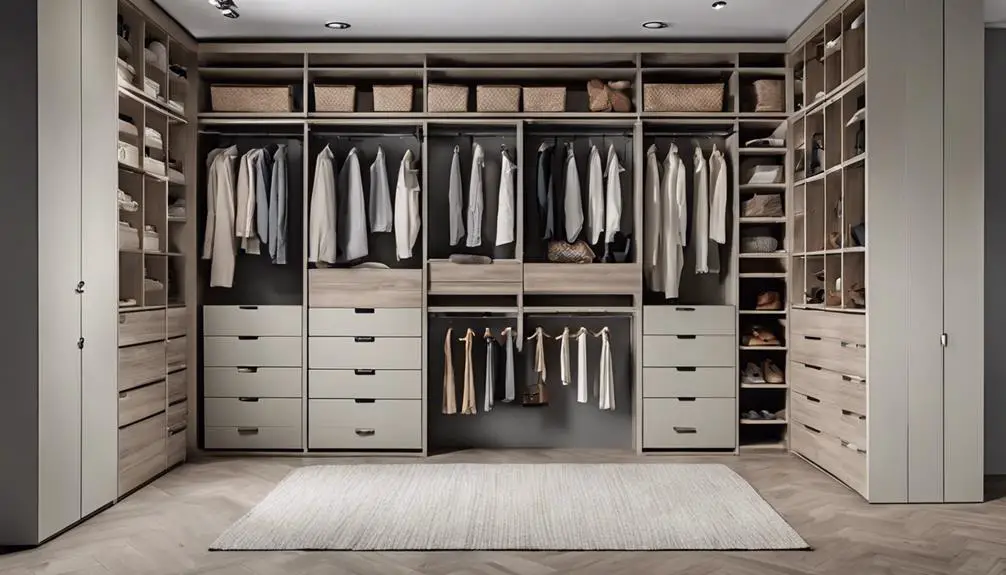
You'll find that shelving options abound, ranging from fixed shelves to adjustable ones, and from simple units to elaborate systems.
Shelving Options Abound
By the time you're ready to tackle your closet organization project, you'll have already purged your closet of items you no longer need or want, and now it's time to think about shelving options.
Shelving is a vital aspect of closet organization, as it provides a place to store your belongings while keeping them organized and easily accessible.
You'll find that shelving options abound, offering a range of styles and functionalities to suit your specific needs.
Consider installing floating shelves, which appear to be hovering on the wall, creating a sleek and modern look.
Alternatively, wall-mounted shelves are a great option for maximizing storage space while keeping the floor clear.
These shelves are easy to install and can be adjusted to fit your specific storage needs.
When choosing shelving options, think about the types of items you need to store.
For instance, if you have a lot of folded items like sweaters or jeans, consider installing shelves with a deeper surface area.
If you have a lot of hanging items like dresses or suits, consider installing shelves with a built-in rod or hooks.
Whatever your shelving needs, there's a solution out there to help you achieve your dream closet.
Customizable Storage Solutions
As you begin designing your dream closet, consider incorporating customizable storage solutions to maximize your space.
One of the most effective ways to do this is by installing custom shelves that cater to your specific needs. You can opt for shelves with adjustable compartments to store items of varying sizes, from folded clothes to handbags and accessories.
Adjustable compartments guarantee that you can easily reconfigure your storage space as your needs change.
Custom shelves can be designed to fit snugly into corners, making the most of often-wasted space.
You can also choose shelves with built-in drawers or cabinets for added storage. To take it a step further, consider incorporating pull-out rods or shelves that allow you to easily access items in the back of your closet.
With customizable storage solutions, you can create a closet that's tailored to your unique needs and preferences, certifying that you make the most of your space.
Maximizing Vertical Space
Installing shelves and storage units that maximize your closet's vertical space is essential to creating a functional and organized area.
By doing so, you'll make the most of your closet's often-wasted vertical space, keeping your belongings organized and easily accessible. Consider installing vertical shelves that reach from floor to ceiling, providing ample storage for infrequently used items like out-of-season clothing or luggage.
Take it a step further by utilizing ceiling storage, where you can store items like bins, baskets, or even luggage.
This will help keep your closet floor clear and create a sense of openness. When selecting storage units, choose ones with adjustable shelves to accommodate items of varying sizes.
Additionally, consider installing shelves with built-in drawers or cabinets to store smaller items like accessories or jewelry.
Maximize Corner Closet Space
You can turn that often-wasted corner closet space into a functional area with a few clever strategies.
One effective approach is to install corner shelves, which can be custom-made to fit your closet's unique dimensions.
These shelves provide additional storage for folded items like sweaters, jeans, or blankets, keeping them organized and easily accessible.
Another solution is to use curved organizers, designed specifically for corner spaces.
These innovative systems feature rotating carousels or baskets that maximize every inch of corner space.
They're perfect for storing accessories, bags, or linens, and can be easily adjusted to accommodate items of various sizes.
When selecting a corner storage solution, consider the type of items you want to store and the frequency of use.
For instance, if you need quick access to everyday essentials, opt for a shelf or carousel that's easy to reach.
Implement a Shoe Storage Solution
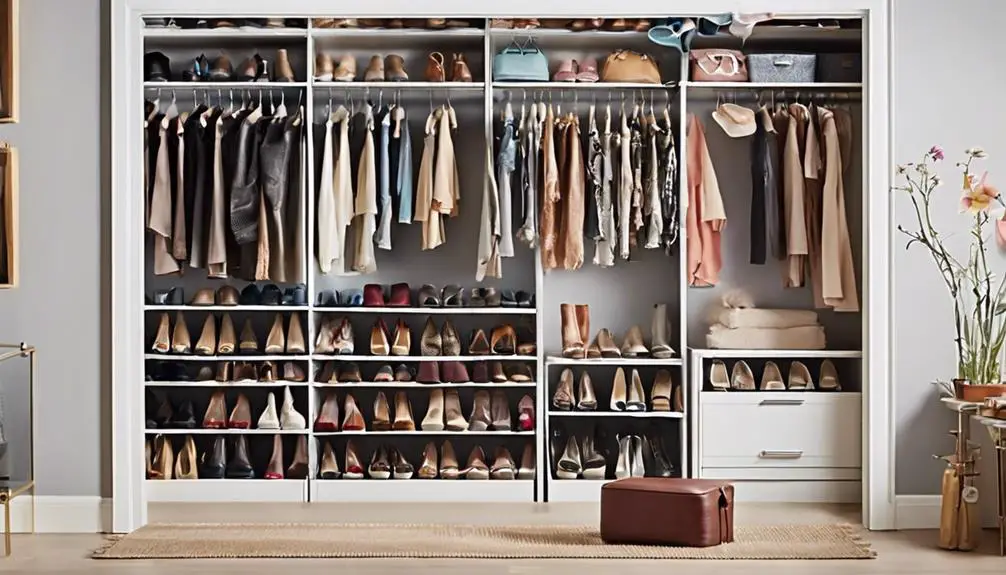
How many times have you tripped over a scattered pile of shoes in your closet, only to waste precious time searching for the perfect pair?
It's a frustrating problem that can be solved with a shoe storage solution. Implementing a shoe rack system can help you keep your shoes organized, visible, and easily accessible. You can opt for a floor-standing shoe rack or a wall-mounted one, depending on your closet's layout and space.
Consider a shoe rack with individual slots to store each pair, keeping them from getting jumbled. For high-heeled shoes, look for a rack with heel storage, which will keep them from toppling over. This feature will also protect the heels from damage.
Organize Closet Accessories and Tools
Scores of closet accessories and tools, like garment bags, lint rollers, and sewing kits, often get jumbled together, making it difficult to find what you need when you need it.
To combat this, designate a specific area of your closet for these items and use closet dividers to separate them from your clothing. Within this section, utilize accessory hangers with pockets or hooks to hang belts, scarves, and hats, keeping them organized and easy to access.
Keep frequently used items, like lint rollers and travel-sized accessories, in a convenient location, such as on a shelf or in a basket near the front of your closet.
Less frequently used items, like sewing kits or garment bags, can be stored on higher or lower shelves. Consider using stackable bins or baskets with labels to store small items like buttons, safety pins, or beads.
Create a Closet Station for Jewelry

A dozen jewelry pieces can quickly turn into a tangled mess without a designated spot to store and organize them.
To keep your jewelry collection in check, create a closet station specifically for your accessories. Install a jewelry display on a wall or on the back of a door, featuring hooks, knobs, or a grid to hang your necklaces, bracelets, and earrings.
This will keep them visible, making it easier to choose the perfect piece to match your outfit. For added jewelry security, consider a locked cabinet or a safe with a glass front to showcase your most precious items while keeping them protected from theft or damage.
You can also add a small tray or dish to store rings and other small items. By creating a dedicated space for your jewelry, you'll be able to find what you need quickly and easily, and your closet will feel more organized and clutter-free.
Invest in Closet Storage Bins
You've likely accumulated a collection of clothes, shoes, and accessories over the years, and without a proper storage system, they can quickly clutter your closet.
Investing in closet storage bins is a great way to keep your belongings organized and out of sight.
Choose bins that fit your storage style, whether it's modern and sleek or traditional and ornate.
Consider bins with labels or create your own labels to categorize your items. This will make it easy to find what you need and prevent clutter from building up in the future.
Select bins that are durable, easy to clean, and can hold a decent amount of weight. You can use them to store items like socks, underwear, accessories, or even out-of-season clothing.
To maximize your storage space, consider stackable bins or ones with lids.
These will allow you to store more items in a smaller area, keeping your closet floor clear and clutter-free.
Designate a Closet Area for Folding
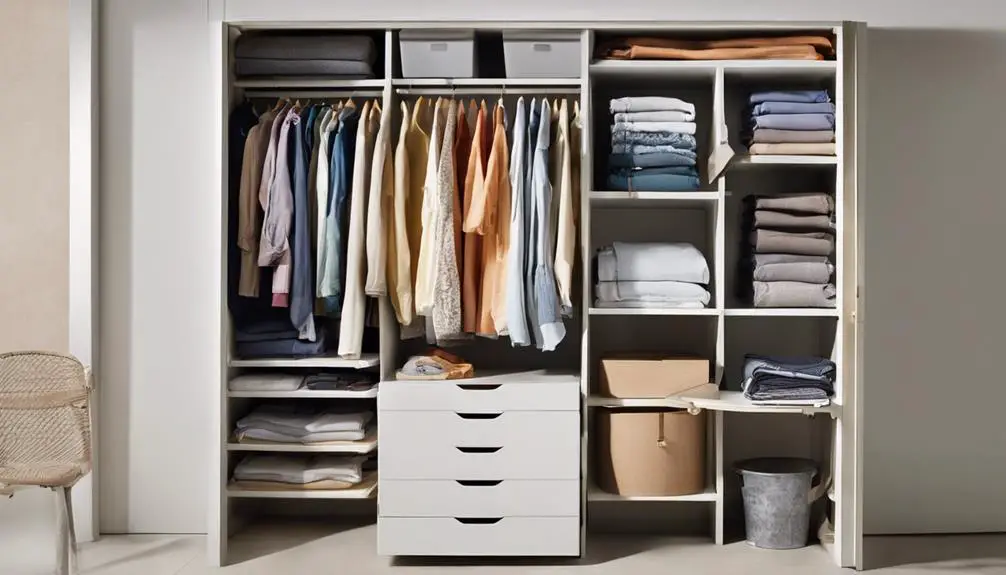
This dedicated folding area is essential for maintaining your closet's organization and making the most of your space.
By designating a specific area for folding, you'll avoid cluttering your closet floor with piles of clothes and create a more efficient workflow.
To create a functional folding station, consider installing a folding table or a countertop with built-in storage.
This will provide a dedicated surface for folding and a place to store your folding supplies, such as a folding board or laundry sorter.
When choosing a folding table, look for one with adjustable height settings to accommodate your comfort level.
You can also opt for a wall-mounted folding station to maximize floor space.
Additionally, consider the size of your folding area and the type of items you'll be folding most frequently.
This will help you determine the ideal size and layout of your folding station.
Add a Closet Seating Area
Having optimized your closet's folding station, turn your attention to creating a comfortable seating area.
This cozy nook will become your comfort zone, where you can sit, relax, and recharge while getting ready.
To start, consider the space you have available. A window seat or a built-in bench can be an excellent option, providing a soft, cushioned surface to sit on.
You can also add a plush ottoman or a stylish chair, depending on your personal style and preferences.
Next, think about the lighting.
A table lamp or a floor lamp can add warm, soft illumination, creating a peaceful ambiance.
Add some decorative pillows, a few favorite books, or a small side table to make the space feel more inviting.
Don't forget to incorporate some calming colors, such as beige, blue, or green, to promote relaxation.
Frequently Asked Questions
Can I DIY My Closet Organization or Do I Need a Professional?
You can definitely DIY your closet organization, but consider your DIY limitations; if you're short on time or lack design expertise, hiring a professional brings benefits like customized solutions, increased storage, and a stress-free process.
How Often Should I Clean and Maintain My Organized Closet?
You should establish daily routines to maintain your space, like putting away items after use, and schedule seasonal refreshes to reassess and adjust your organization system, ensuring it remains functional and clutter-free.
Are Closet Organization Systems Worth the Investment?
When considering any investment, you weigh the cost benefit, and it's no different here; you're deciding if a system aligns with your personal style, providing a return on investment with regard to time, space, and reduced stress.
Can I Use Reclaimed or Repurposed Materials for Closet Organization?
You can get creative with reclaimed wood and upcycled crates to create a unique, eco-friendly storage solution; repurpose old pallets, crates, or wooden boxes to craft shelves, drawers, or hanging rods that reflect your personal style.
How Do I Keep My Closet Organized When Sharing With a Partner?
When sharing a space with a partner, you'll need to establish clear expectations and boundaries to avoid double standards. Designate zones, communicate regularly, and set mutual goals to maintain harmony and keep your shared space organized.
Conclusion
You've tackled the task of organizing your closet, and now you can reap the benefits! With a clutter-free space, categorized items, and optimized storage, you'll save time getting ready and reduce stress. Your newly designed closet is a peaceful retreat, complete with a seating area, where you can relax and enjoy your morning routine. Pat yourself on the back – you've created a functional and serene space that's all your own!
